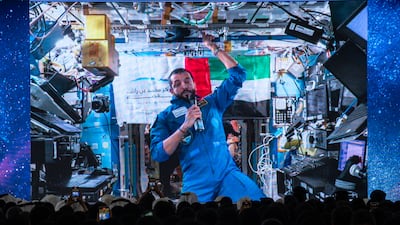An Abu Dhabi scientist has detected water on a planet 400 light years from Earth, using the James Webb Space Telescope.
The discovery raises more hopes that water – and life – may be found on other planets.
The water vapour was located on Wasp-18b using data from the James Webb, which offers a much more detailed view of distant planets than earlier telescopes.
Wasp-18b is what scientists call the gas giant and temperatures on its surface are 2,700°C – and higher inside.
Dr Jasmina Blecic, of New York University Abu Dhabi's Centre for Astro, Particle and Planetary Physics, and her co-authors, have published their findings on Wasp-18b in the scientific journal, Nature.
This demonstrates the capability of the James Webb Space Telescope to identify minuscule quantities of certain chemical species
Dr Jasmina Blecic,
New York University Abu Dhabi's Centre for Astro, Particle and Planetary Physics
“This is the first time we could see very small amounts of water in the atmosphere of this planet,” Dr Blecic told The National.
“This demonstrates the capability of the James Webb Space Telescope to identify minuscule quantities of certain chemical species, opening the possibility of detecting these molecules in smaller, Earth-sized planets,” she said.
The planet has been observed since 2009 with a variety of telescopes, but astronomers were unable to tell whether it contained water or not.
Most water on Wasp-18b is destroyed by the heat, but the high sensitivity of Nasa's James Webb Space Telescope, which has impressed researchers with high quality data since it was launched into space on a rocket in December 2021, meant that it is capable of detecting even subtle indications of water vapour.
Detecting water on Earth-sized planets may be significant because it could indicate that these planets – unlike Wasp-18b – harbour life.
Wasp-18b has a radius (the distance from the centre to the surface) about 10 times that of Earth, but it has a mass 3,000 times that of our planet.
“This is one of the densest planets we have ever observed,” Dr Blecic said. “This is one reason why it’s super interesting. It’s dense but it’s still only made from gas. It doesn’t have any solid surface.”
Scientists think that Wasp-18b formed from gas when its star formed, because the two are of similar composition.
The water was detected by analysing the infrared light emitted by Wasp-18b as it passed behind its star and reappeared.
The same side of Wasp-18b, known as the dayside, always faces the star, causing a significant temperature difference of about 1,000°C between the hottest part of the surface and the terminator, the dividing line between the day and night sides.
In the study, the scientists created a detailed temperature map.
One unusual feature of the planet is that winds do not flow from the hottest parts to the cooler areas, as would normally be expected.
A strong magnetic field that causes winds to instead blow from the equator over each of the poles could be the reason for this.
“It’s not easily understandable from solar system examples – most are blowing from high pressure, hot to low pressure, cold,” Dr Blecic said.
She plans to continue detailed studies of Wasp-18b in the hope of confirming that material is in fact transferred from the equator to the poles.
At 400 light years from Earth, Wasp-18b is at a distance that is difficult for the human mind to comprehend, given that one light year is about 150 million kilometres.
Yet Wasp-18b is extremely near to us in the context of our galaxy, the Milky Way, which is about 100,000 light years across.
“It’s very close to our sun,” Dr Blecic said.
There are an estimated 200 billion galaxies in the observable universe, which is about 94 billion light years across, according to data published by Nasa.
Dr Blecic has also published research on Wasp-39b, a planet that orbits a star about 700 light years from Earth.
Also using data from the James Webb, Dr Blecic and her colleagues detected carbon dioxide in the atmosphere of Wasp-39b.
This made it the first exoplanet, which is a planet orbiting a star outside our solar system where carbon dioxide has been detected.
Space activities in the Middle East – in pictures
Killing of Qassem Suleimani
Mohammed bin Zayed Majlis
More from Neighbourhood Watch:
More on animal trafficking
More from Neighbourhood Watch
%E2%80%98FSO%20Safer%E2%80%99%20-%20a%20ticking%20bomb
%3Cp%3EThe%20%3Cem%3ESafer%3C%2Fem%3E%20has%20been%20moored%20off%20the%20Yemeni%20coast%20of%20Ras%20Issa%20since%201988.%3Cbr%3EThe%20Houthis%20have%20been%20blockading%20UN%20efforts%20to%20inspect%20and%20maintain%20the%20vessel%20since%202015%2C%20when%20the%20war%20between%20the%20group%20and%20the%20Yemen%20government%2C%20backed%20by%20the%20Saudi-led%20coalition%20began.%3Cbr%3ESince%20then%2C%20a%20handful%20of%20people%20acting%20as%20a%20%3Ca%20href%3D%22https%3A%2F%2Fwww.google.ae%2Furl%3Fsa%3Dt%26rct%3Dj%26q%3D%26esrc%3Ds%26source%3Dweb%26cd%3D%26ved%3D2ahUKEwiw2OfUuKr4AhVBuKQKHTTzB7cQFnoECB4QAQ%26url%3Dhttps%253A%252F%252Fwww.thenationalnews.com%252Fworld%252Fmena%252Fyemen-s-floating-bomb-tanker-millions-kept-safe-by-skeleton-crew-1.1104713%26usg%3DAOvVaw0t9FPiRsx7zK7aEYgc65Ad%22%20target%3D%22_self%22%3Eskeleton%20crew%3C%2Fa%3E%2C%20have%20performed%20rudimentary%20maintenance%20work%20to%20keep%20the%20%3Cem%3ESafer%3C%2Fem%3E%20intact.%3Cbr%3EThe%20%3Cem%3ESafer%3C%2Fem%3E%20is%20connected%20to%20a%20pipeline%20from%20the%20oil-rich%20city%20of%20Marib%2C%20and%20was%20once%20a%20hub%20for%20the%20storage%20and%20export%20of%20crude%20oil.%26nbsp%3B%3C%2Fp%3E%0A%3Cp%3EThe%20%3Cem%3ESafer%3C%2Fem%3E%E2%80%99s%20environmental%20and%20humanitarian%20impact%20may%20extend%20well%20beyond%20Yemen%2C%20experts%20believe%2C%20into%20the%20surrounding%20waters%20of%20Saudi%20Arabia%2C%20Djibouti%20and%20Eritrea%2C%20impacting%20marine-life%20and%20vital%20infrastructure%20like%20desalination%20plans%20and%20fishing%20ports.%C2%A0%3C%2Fp%3E%0A
What are NFTs?
Are non-fungible tokens a currency, asset, or a licensing instrument? Arnab Das, global market strategist EMEA at Invesco, says they are mix of all of three.
You can buy, hold and use NFTs just like US dollars and Bitcoins. “They can appreciate in value and even produce cash flows.”
However, while money is fungible, NFTs are not. “One Bitcoin, dollar, euro or dirham is largely indistinguishable from the next. Nothing ties a dollar bill to a particular owner, for example. Nor does it tie you to to any goods, services or assets you bought with that currency. In contrast, NFTs confer specific ownership,” Mr Das says.
This makes NFTs closer to a piece of intellectual property such as a work of art or licence, as you can claim royalties or profit by exchanging it at a higher value later, Mr Das says. “They could provide a sustainable income stream.”
This income will depend on future demand and use, which makes NFTs difficult to value. “However, there is a credible use case for many forms of intellectual property, notably art, songs, videos,” Mr Das says.
SPEC%20SHEET%3A%20APPLE%20IPAD%20PRO%20(12.9%22%2C%202022)
%3Cp%3E%3Cstrong%3EDisplay%3A%3C%2Fstrong%3E%2012.9-inch%20Liquid%20Retina%20XDR%2C%202%2C732%20x%202%2C048%2C%20264ppi%2C%20wide%20colour%2C%20True%20Tone%2C%20ProMotion%2C%201%2C600%20nits%20max%2C%20Apple%20Pencil%20hover%3C%2Fp%3E%0A%3Cp%3E%3Cstrong%3EChip%3A%3C%2Fstrong%3E%20Apple%20M2%2C%208-core%20CPU%2C%2010-core%20GPU%2C%2016-core%20Neural%20Engine%3C%2Fp%3E%0A%3Cp%3E%3Cstrong%3EMemory%3A%3C%2Fstrong%3E%20Storage%20%E2%80%93%20128GB%2F256GB%2F512GB%20%2F%201TB%2F2TB%3B%20RAM%20%E2%80%93%208GB%2F16GB%3C%2Fp%3E%0A%3Cp%3E%3Cstrong%3EPlatform%3A%3C%2Fstrong%3E%20iPadOS%2016%3C%2Fp%3E%0A%3Cp%3E%3Cstrong%3EMain%20camera%3A%3C%2Fstrong%3E%20Dual%2012MP%20wide%20(f%2F1.8)%20%2B%2010MP%20ultra-wide%20(f%2F2.4)%2C%202x%20optical%2F5x%20digital%2C%20Smart%20HDR%204%3C%2Fp%3E%0A%3Cp%3E%3Cstrong%3EVideo%3A%3C%2Fstrong%3E%20ProRes%204K%20%40%2030fps%2C%204K%20%40%2024%2F25%2F30%2F60fps%2C%20full%20HD%20%40%2025%2F30%2F60fps%2C%20slo-mo%20%40%20120%2F240fps%3C%2Fp%3E%0A%3Cp%3E%3Cstrong%3EFront%20camera%3A%3C%2Fstrong%3E%20TrueDepth%2012MP%20ultra-wide%20(f%2F2.4)%2C%202x%2C%20Smart%20HDR%204%2C%20Centre%20Stage%2C%20Portrait%2C%20Animoji%2C%20Memoji%3B%20full%20HD%20%40%2025%2F30%2F60fps%3C%2Fp%3E%0A%3Cp%3E%3Cstrong%3EAudio%3A%3C%2Fstrong%3E%20Four-speaker%20stereo%3C%2Fp%3E%0A%3Cp%3E%3Cstrong%3EBiometrics%3A%3C%2Fstrong%3E%20Face%20ID%2C%20Touch%20ID%3C%2Fp%3E%0A%3Cp%3E%3Cstrong%3EI%2FO%3A%3C%2Fstrong%3E%20USB-C%2C%20smart%20connector%20(for%20folio%2Fkeyboard)%3C%2Fp%3E%0A%3Cp%3E%3Cstrong%3EBattery%3A%3C%2Fstrong%3E%20Up%20to%2010%20hours%20on%20Wi-Fi%3B%20up%20to%20nine%20hours%20on%20cellular%3C%2Fp%3E%0A%3Cp%3E%3Cstrong%3EFinish%3A%3C%2Fstrong%3E%20Silver%2C%20space%20grey%3C%2Fp%3E%0A%3Cp%3E%3Cstrong%3EIn%20the%20box%3A%3C%2Fstrong%3E%20iPad%2C%20USB-C-to-USB-C%20cable%2C%2020-watt%20power%20adapter%3C%2Fp%3E%0A%3Cp%3E%3Cstrong%3EPrice%3A%3C%2Fstrong%3E%20WiFi%20%E2%80%93%20Dh4%2C599%20(128GB)%20%2F%20Dh4%2C999%20(256GB)%20%2F%20Dh5%2C799%20(512GB)%20%2F%20Dh7%2C399%20(1TB)%20%2F%20Dh8%2C999%20(2TB)%3B%20cellular%20%E2%80%93%20Dh5%2C199%20%2F%20Dh5%2C599%20%2F%20Dh6%2C399%20%2F%20Dh7%2C999%20%2F%20Dh9%2C599%3C%2Fp%3E%0A
Uefa Nations League
League A:
Germany, Portugal, Belgium, Spain, France, England, Switzerland, Italy, Poland, Iceland, Croatia, Netherlands
League B:
Austria, Wales, Russia, Slovakia, Sweden, Ukraine, Republic of Ireland, Bosnia-Herzegovina, Northern Ireland, Denmark, Czech Republic, Turkey
League C:
Hungary, Romania, Scotland, Slovenia, Greece, Serbia, Albania, Norway, Montenegro, Israel, Bulgaria, Finland, Cyprus, Estonia, Lithuania
League D:
Azerbaijan, Macedonia, Belarus, Georgia, Armenia, Latvia, Faroe Islands, Luxembourg, Kazakhstan, Moldova, Liechtenstein, Malta, Andorra, Kosovo, San Marino, Gibraltar
The view from The National
The%20Genius%20of%20Their%20Age
%3Cp%3EAuthor%3A%20S%20Frederick%20Starr%3Cbr%3EPublisher%3A%20Oxford%20University%20Press%3Cbr%3EPages%3A%20290%3Cbr%3EAvailable%3A%20January%2024%3C%2Fp%3E%0A
SPEC%20SHEET
%3Cp%3E%3Cstrong%3EProcessor%3A%3C%2Fstrong%3E%20Apple%20M2%2C%208-core%20CPU%2C%20up%20to%2010-core%20CPU%2C%2016-core%20Neural%20Engine%3C%2Fp%3E%0A%3Cp%3E%3Cstrong%3EDisplay%3A%3C%2Fstrong%3E%2013.6-inch%20Liquid%20Retina%2C%202560%20x%201664%2C%20224ppi%2C%20500%20nits%2C%20True%20Tone%2C%20wide%20colour%3C%2Fp%3E%0A%3Cp%3E%3Cstrong%3EMemory%3A%3C%2Fstrong%3E%208%2F16%2F24GB%3C%2Fp%3E%0A%3Cp%3E%3Cstrong%3EStorage%3A%3C%2Fstrong%3E%20256%2F512GB%20%2F%201%2F2TB%3C%2Fp%3E%0A%3Cp%3E%3Cstrong%3EI%2FO%3A%3C%2Fstrong%3E%20Thunderbolt%203%20(2)%2C%203.5mm%20audio%2C%20Touch%20ID%3C%2Fp%3E%0A%3Cp%3E%3Cstrong%3EConnectivity%3A%3C%2Fstrong%3E%20Wi-Fi%206%2C%20Bluetooth%205.0%3C%2Fp%3E%0A%3Cp%3E%3Cstrong%3EBattery%3A%3C%2Fstrong%3E%2052.6Wh%20lithium-polymer%2C%20up%20to%2018%20hours%2C%20MagSafe%20charging%3C%2Fp%3E%0A%3Cp%3E%3Cstrong%3ECamera%3A%3C%2Fstrong%3E%201080p%20FaceTime%20HD%3C%2Fp%3E%0A%3Cp%3E%3Cstrong%3EVideo%3A%3C%2Fstrong%3E%20Support%20for%20Apple%20ProRes%2C%20HDR%20with%20Dolby%20Vision%2C%20HDR10%3C%2Fp%3E%0A%3Cp%3E%3Cstrong%3EAudio%3A%3C%2Fstrong%3E%204-speaker%20system%2C%20wide%20stereo%2C%20support%20for%20Dolby%20Atmos%2C%20Spatial%20Audio%20and%20dynamic%20head%20tracking%20(with%20AirPods)%3C%2Fp%3E%0A%3Cp%3E%3Cstrong%3EColours%3A%3C%2Fstrong%3E%20Silver%2C%20space%20grey%2C%20starlight%2C%20midnight%3C%2Fp%3E%0A%3Cp%3E%3Cstrong%3EIn%20the%20box%3A%3C%2Fstrong%3E%20MacBook%20Air%2C%2030W%20or%2035W%20dual-port%20power%20adapter%2C%20USB-C-to-MagSafe%20cable%3C%2Fp%3E%0A%3Cp%3E%3Cstrong%3EPrice%3A%3C%2Fstrong%3E%20From%20Dh4%2C999%3C%2Fp%3E%0A
Lexus LX700h specs
Engine: 3.4-litre twin-turbo V6 plus supplementary electric motor
Power: 464hp at 5,200rpm
Torque: 790Nm from 2,000-3,600rpm
Transmission: 10-speed auto
Fuel consumption: 11.7L/100km
On sale: Now
Price: From Dh590,000
A little about CVRL
Founded in 1985 by Sheikh Mohammed bin Rashid, Vice President and Ruler of Dubai, the Central Veterinary Research Laboratory (CVRL) is a government diagnostic centre that provides testing and research facilities to the UAE and neighbouring countries.
One of its main goals is to provide permanent treatment solutions for veterinary related diseases.
The taxidermy centre was established 12 years ago and is headed by Dr Ulrich Wernery.
How do Sim card scams work?
Sim swap frauds are a form of identity theft.
They involve criminals conning mobile phone operators into issuing them with replacement Sim cards by claiming to be the victim, often pretending their phone has been lost or stolen in order to secure a new Sim.
They use the victim's personal details - obtained through criminal methods - to convince such companies of their identity.
The criminal can then access any online service that requires security codes to be sent to a user's mobile phone, such as banking services.
Ticket prices
General admission Dh295 (under-three free)
Buy a four-person Family & Friends ticket and pay for only three tickets, so the fourth family member is free
Buy tickets at: wbworldabudhabi.com/en/tickets
Full list of Emmy 2020 nominations
LEAD ACTOR IN A COMEDY SERIES
Anthony Anderson, Black-ish
Don Cheadle, Black Monday
Ted Danson, The Good Place
Michael Douglas, The Kominsky Method
Eugene Levy, Schitt’s Creek
Ramy Youssef, Ramy
LEAD ACTRESS IN A COMEDY SERIES
Christina Applegate, Dead to Me
Rachel Brosnahan, The Marvelous Mrs. Maisel
Linda Cardellini, Dead to Me
Catherine O’Hara, Schitt’s Creek
Issa Rae, Insecure
Tracee Ellis Ross, Black-ish
OUTSTANDING VARIETY/TALK SERIES
The Daily Show with Trevor Noah
Full Frontal with Samantha Bee
Jimmy Kimmel Live
Last Week Tonight with John Oliver
The Late Show with Stephen Colbert
LEAD ACTOR IN A DRAMA SERIES
Jason Bateman, Ozark
Sterling K. Brown, This Is Us
Steve Carell, The Morning Show
Brian Cox, Succession
Billy Porter, Pose
Jeremy Strong, Succession
LEAD ACTRESS IN A DRAMA SERIES
Jennifer Aniston, The Morning Show
Olivia Colman, The Crown
Jodie Comer, Killing Eve
Laura Linney, Ozark
Sandra Oh, Killing Eve
Zendaya, Euphoria
OUTSTANDING REALITY/COMPETITION PROGRAM
The Masked Singer
Nailed It!
RuPaul’s Drag Race
Top Chef
The Voice
LEAD ACTOR IN A LIMITED SERIES/TV MOVIE
Jeremy Irons, Watchmen
Hugh Jackman, Bad Education
Paul Mescal, Normal People
Jeremy Pope, Hollywood
Mark Ruffalo, I Know This Much Is True
LEAD ACTRESS IN A LIMITED SERIES/TV MOVIE
Cate Blanchett, Mrs. America
Shira Haas, Unorthodox
Regina King, Watchmen
Octavia Spencer, Self Made
Kerry Washington, Little Fires Everywhere
OUTSTANDING LIMITED SERIES
Little Fires Everywhere
Mrs. America
Unbelievable
Unorthodox
Watchmen
OUTSTANDING COMEDY SERIES
Curb Your Enthusiasm
Dead to Me
The Good Place
Insecure
The Kominsky Method
The Marvelous Mrs. Maisel
Schitt’s Creek
What We Do In The Shadows
OUTSTANDING DRAMA SERIES
Better Call Saul
The Crown
The Handmaid’s Tale
Killing Eve
The Mandalorian
Ozark
Stranger Things
Succession
RESULT
Manchester City 5 Swansea City 0
Man City: D Silva (12'), Sterling (16'), De Bruyne (54' ), B Silva (64' minutes), Jesus (88')
LA LIGA FIXTURES
Thursday (All UAE kick-off times)
Sevilla v Real Betis (midnight)
Friday
Granada v Real Betis (9.30pm)
Valencia v Levante (midnight)
Saturday
Espanyol v Alaves (4pm)
Celta Vigo v Villarreal (7pm)
Leganes v Real Valladolid (9.30pm)
Mallorca v Barcelona (midnight)
Sunday
Atletic Bilbao v Atletico Madrid (4pm)
Real Madrid v Eibar (9.30pm)
Real Sociedad v Osasuna (midnight)
A Prayer Before Dawn
Director: Jean-Stephane Sauvaire
Starring: Joe Cole, Somluck Kamsing, Panya Yimmumphai
Three stars
THE SPECS
Engine: 4.4-litre V8
Transmission: Automatic
Power: 530bhp
Torque: 750Nm
Price: Dh535,000
On sale: Now








